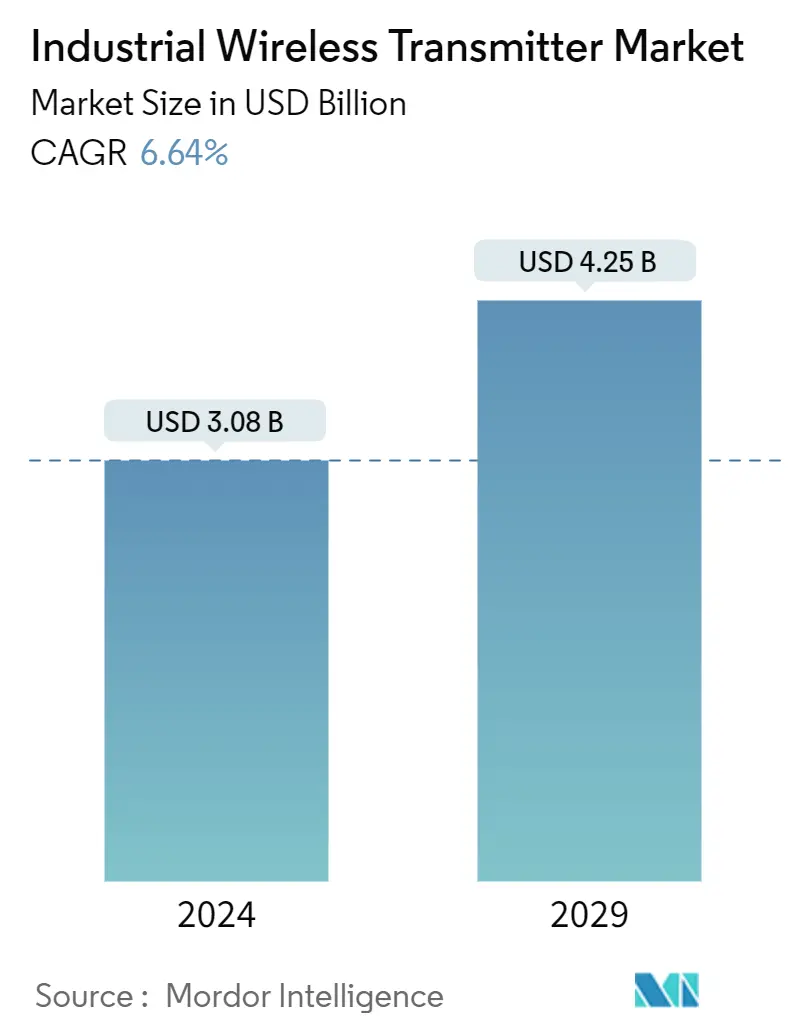Market Size of Industrial Wireless Transmitter Industry

| Study Period | 2019 - 2029 |
| Market Size (2024) | USD 3.08 Billion |
| Market Size (2029) | USD 4.25 Billion |
| CAGR (2024 - 2029) | 6.64 % |
| Fastest Growing Market | Asia Pacific |
| Largest Market | North America |
| Market Concentration | Low |
Major Players
*Disclaimer: Major Players sorted in no particular order |
Industrial Wireless Transmitter Market Analysis
The Industrial Wireless Transmitter Market size is estimated at USD 3.08 billion in 2024, and is expected to reach USD 4.25 billion by 2029, growing at a CAGR of 6.64% during the forecast period (2024-2029).
Industrial wireless transmitters network has viewed immense growth as technology companies globally accelerated innovation in the fight against the COVID-19 pandemic. The need for tiny devices is behind advances in electronics, thus, ranging from thermal imaging and faster point-of-care testing to microfluidics-based polymerase chain reaction (PCR) tools and techniques to detect SARS-CoV-2.
- Industrial wireless temperature transmitters and sensors in the market employed Internet of Things (IoT) connectivity to speed up COVID-19 screening. Multiple companies joined forces to develop a series of human body temperature monitoring wearable devices. The wearable devices' transmitters offered real-time data to frontline healthcare workers and let them quickly screen individuals with a high temperature, one of the most common symptoms of COVID-19. Moreover, Shanghai Public Health Clinical Center (SPHCC) used California-based connected health startup VivaLNK's continuous wireless temperature transmitters and sensors network to monitor COVID-19 patients, which decreased the risks of caregivers being exposed to the virus.
- The growing automation and robotics industry, growing demand for a wireless transmitter network in asset monitoring, security, and transportation, and improved reliability with communication technology advancements are the influential factors driving the industrial wireless transmitter market.
- These transmitters are primarily used in factory settings for data monitoring of production flow. These also find applications in defense, building automation, and other industries, like materials handling and food and beverage.
- Due to the increased government regulation for the increased use of transmitters for safety, the demand for wireless transmitters is growing. For example, the areas with challenging environmental conditions, such as extreme high pressure, high temperature, etc. With the help of industrial wireless transmitters, it becomes easy to control and monitor the facility from a safe distance continually. They help to acquire the data from locations that are difficult to access.
- Further, transforming the growth of smart homes and buildings, smart cities, and smart factories demand the use of industrial wireless transmitters, owing to the small form factor, low power consumption, high precision, and ability to control and monitor ambient parameters (such as humidity, pressure, and air quality) in smart homes with the help of wireless technologies.
- As the automotive industry strives to comply with worldwide environmental regulations, the efforts to boost efficiency and achieve better control of engine systems are more crucial than ever. These applications demand efficient wireless transmitter networks to accurately monitor conditions through Bluetooth technology, and battery-free radio frequency identification (RFID) technology enhances efficiency by concentrating on non-critical systems inside vehicles.
- In November 2022, OleumTech introduced two new Hydrogen Sulfide (H2S) Gas Detection Transmitters: one to its OTC Wireless Sensor Network platform and the other to its H Series hardwired process instrumentation product line. The new H2S Transmitters were designed to continuously monitor air quality and generate alarms when H2S levels exceed user-configured setpoints.
- Further, in June 2022, Optex Co., Ltd. launched the Multi-Converter OWU-300M Series IoT wireless units, which use LTE-Cat M1*1 as their communication standard. Optex’s IoT wireless units make IoT possible by simply connecting existing transmitters, sensors, and switches, allowing for simple monitoring of sensor data and operational status from remote locations.
Industrial Wireless Transmitter Industry Segmentation
Transmitters convey information through radio waves and are used for various industry functions. The inclusion of wireless connectivity in industries is found to increase the reliability of systems. The use of wires for transmitters poses multiple challenges for the location and limits the connectivity of the transmitters through wires. These wires also provide a complex system to maintain and operate. The wireless networks have now achieved the industrial standard and are ready to be implemented in an industrial workspace. Implementing systems, such as SCADA, can also be eased compared to wired infrastructure, as the hassles of rewiring a system to make it visible can be removed.
The industrial wireless transmitter market is segmented by type (general purpose, level transmitters, pressure transmitters, flow transmitters, temperature transmitters, and other types), end-user (energy and power, food and agriculture, industrial automation, water, and wastewater treatment, and other end-users), and geography (North America, Latin America, Europe, Asia-Pacific, and Middle East and Africa). The impact of macroeconomic trends on the market is also covered under the scope of the study. The market sizes and forecasts are provided in terms of value in (USD) for all the above segments.
| Type | |
| General Purpose | |
| Level Transmitters | |
| Pressure Transmitters | |
| Temperature Transmitters | |
| Flow Transmitters | |
| Other Types |
| End User | |
| Energy and Power | |
| Food and Agriculture | |
| Industrial Automation | |
| Water and waste water Treatment | |
| Other End-users |
| Geography | |
| North America | |
| Europe | |
| Asia Pacific | |
| Latin America | |
| Middle East and Africa |
Industrial Wireless Transmitter Market Size Summary
The industrial wireless transmitter market is experiencing significant growth, driven by advancements in technology and the increasing demand for automation and connectivity across various sectors. The market is characterized by the integration of Internet of Things (IoT) capabilities, which have enhanced the functionality and application of wireless transmitters in industries such as healthcare, energy, and manufacturing. The COVID-19 pandemic accelerated the adoption of these technologies, as they facilitated real-time monitoring and data collection, proving essential in scenarios like temperature screening and patient monitoring. The market is further bolstered by the growing trend of smart homes, smart cities, and smart factories, where wireless transmitters play a crucial role in controlling and monitoring environmental parameters with high precision and low power consumption.
The market landscape is competitive and fragmented, with numerous key players actively expanding their product offerings and market presence through innovations and strategic partnerships. The energy and electricity sectors are primary end-users, benefiting from the ease of installation and flexibility of wireless transmitters in monitoring equipment in challenging environments. North America stands out as a significant market due to its high manufacturing activity and the increasing adoption of automation and connected solutions. The region's demand is further fueled by the shale gas industry, where wireless transmitters are vital for monitoring resource flow and storage. As the market continues to evolve, the focus on enhancing product capabilities and expanding applications across various industries remains a priority for leading companies.
Industrial Wireless Transmitter Market Size - Table of Contents
-
1. MARKET INSIGHTS
-
1.1 Market Overview
-
1.2 Technology Overview
-
1.3 Industry Attractiveness - Porter's Five Forces Analysis
-
1.3.1 Bargaining Power of Suppliers
-
1.3.2 Bargaining Power of Buyers
-
1.3.3 Threat of New Entrants
-
1.3.4 Threat of Substitute Products
-
1.3.5 Intensity of Competitive Rivalry
-
-
1.4 Assessment of Impact of Key Macroeconomic Trends on the Market
-
-
2. MARKET SEGMENTATION
-
2.1 Type
-
2.1.1 General Purpose
-
2.1.2 Level Transmitters
-
2.1.3 Pressure Transmitters
-
2.1.4 Temperature Transmitters
-
2.1.5 Flow Transmitters
-
2.1.6 Other Types
-
-
2.2 End User
-
2.2.1 Energy and Power
-
2.2.2 Food and Agriculture
-
2.2.3 Industrial Automation
-
2.2.4 Water and waste water Treatment
-
2.2.5 Other End-users
-
-
2.3 Geography
-
2.3.1 North America
-
2.3.2 Europe
-
2.3.3 Asia Pacific
-
2.3.4 Latin America
-
2.3.5 Middle East and Africa
-
-
Industrial Wireless Transmitter Market Size FAQs
How big is the Industrial Wireless Transmitter Market?
The Industrial Wireless Transmitter Market size is expected to reach USD 3.08 billion in 2024 and grow at a CAGR of 6.64% to reach USD 4.25 billion by 2029.
What is the current Industrial Wireless Transmitter Market size?
In 2024, the Industrial Wireless Transmitter Market size is expected to reach USD 3.08 billion.

